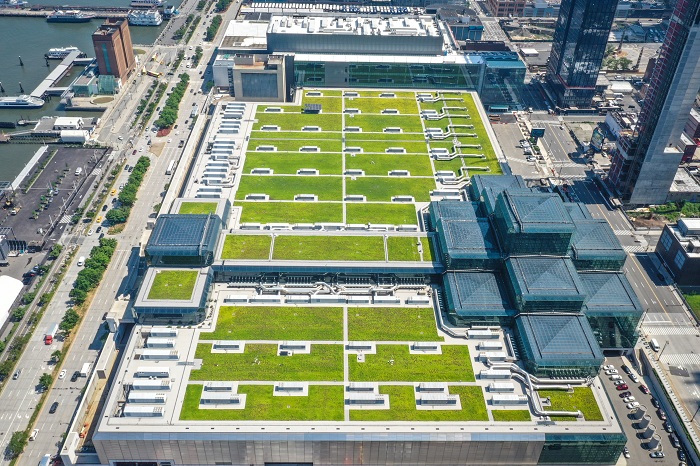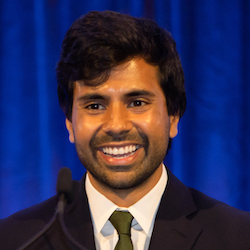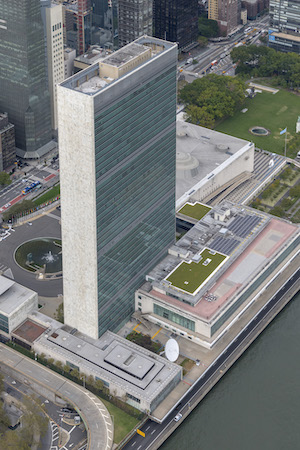
The Javits Center, the United Nations, and the Chrysler Building share more than status as New York City landmarks–they all have, or will have, green roofs designed by a company co-founded by a Vanderbilt engineering alumnus.
Sulman Usman, BS ‘12, is the CEO and a co-founder of Adaptive Green, a leading startup in sustainable roof technology. He also is a Vanderbilt Posse Foundation Scholar alumnus and recently joined the program’s Advisory Board.
Adaptive Green, which launched in 2016, has designed and installed more than half a million square feet of green roofs in New York, Washington, D.C., and California for clients including Toll Brothers, Lendlease, Lennar, and Skidmore Owings & Merrill.
“The problem Adaptive Green has tried to solve is America’s aging stormwater infrastructure and rapid urbanization,” Usman said. “Stormwater and wastewater systems have not been maintained or updated for either climate change or an increased population, causing overflow of raw sewage and polluted stormwater into limited freshwater sources. In the New York Harbor alone, 27 billion gallons of contaminated water are discharged every year.”

Cities have enacted laws requiring new projects to take into account their impact on municipal stormwater infrastructure. That’s doubly difficult in large urban centers such, where land is not only scarce but also astronomically expensive. With no place for adjacent green space to absorb runoff and mitigate potential flooding, roof space becomes an attractive option both for rainwater management, as well as creating accessible green spaces for residents.
“We design and build systems to help cities adapt to climate change, and help architects, civil engineers, and developers meet new building code requirements and create value from a previously underutilized asset–roof spaces.” Usman said.
The UN project is known as the Gandhi Peace Garden and features more than 20,000 square feet of green roof that combine solar panels, which are designed to generate nearly 90,000 kilowatt hours, and plantings that will absorb about 207,000 gallons of water each year.
Adaptive Green was also the design consultant and builder on the green roof for the Javits Center Expansion, which was part of a huge $1.5 billion update of the convention center. Work included expanding the existing green roof and adding a pavilion, greenhouse space, a working fruit orchard, and a 1-acre urban farm. The enhancements will save about 7 million gallons of stormwater each year. The farm and greenhouse provide fresh produce for on-site dining and catering.
The Javits Center now boasts the third largest green roof in the U.S.
Motivated to create green spaces in cities, Usman said he is passionate in developing climate-positive solution that have a solid financial return.

After graduating with a degree in Engineering Science, Usman worked as an analyst at JP Morgan and later, LMN Ventures, an early stage cleantech investment fund. While at LMN he met his future co-founder, Jamison Hinder. Working in the cleantech space, Usman and Hinder realized the clear market need for stormwater management that uses urban landscaping in major cities. This led them to launch Adaptive Green.
Usman, who grew up in The Bronx, followed an older sister to Vanderbilt and into the Posse Foundation Scholarship program. Vanderbilt was the first university to sign on to Posse, in 1989, which recruits and selects a diverse group of students from New York City. Posse now operates all over the country, including New York City and Los Angeles, providing full-tuition scholarships, mentoring, and leadership training and placement at over 60 schools, including Vanderbilt, Northwestern, U.C. Berkley, and Cornell.
Usman credits the Vanderbilt Engineering and the Posse Foundation for providing him the tools to excel. He also credits the Engineer’s School’s interdisciplinary Engineering Science major and Engineering Management Professors Kenneth Pence and John Bers, who was his academic advisor, for providing him a foundation of engineering in practice. He said these early lessons help drive his business decisions every day.
Media contact
Pamela Coyle
School of Engineering